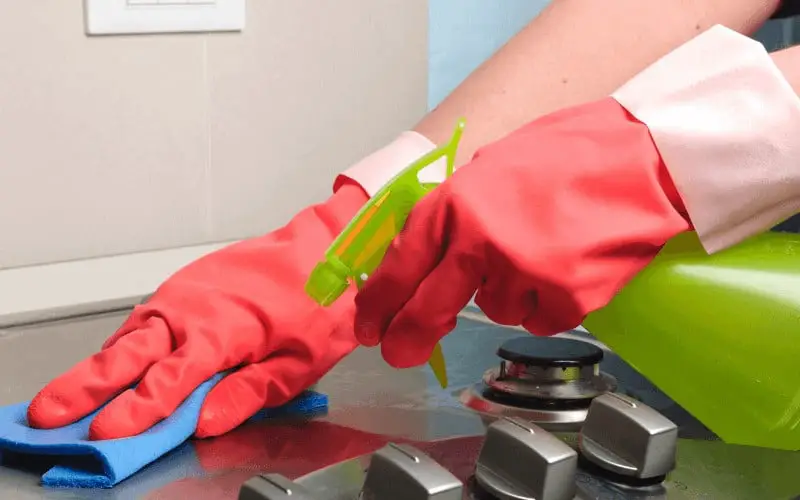A maggot is the larvae of a fly and most refer to it as white worms. When a fly lays eggs they turn into larvae (maggots), which later become flies, which then lay more eggs, and so on…
Flies lay up to hundreds of eggs at a time hatches within a day, hence; the infestation of maggot or white worms in kitchen floor. If you are wondering how to get rid of maggots on kitchen floor, we’ve got you covered.
Read: Can you paint kitchen floor tiles?
How to Get Rid of Maggots on Kitchen Floor
Table of Contents
Locate Cause Of Maggot Infestation
First off, you have to locate the cause of maggot infestation. They don’t just show up for no reason.
Flies are attracted to spoiled or rotting food items and can use that as a breeding ground to lay their eggs which then hatches to become maggots.
A thorough inspection of the infested area will help you pinpoint where the maggots are gathering and this is where you should focus your treatment.
Try inspecting where there is rotting food, organic material, or decaying matter and filth and also check the pantries for spoiled food, pet food, or rotting fruit or produce that has been laid out.
You can also find Maggots in unsealed garbage cans or trash bag that hasn’t been tossed out for some time.
If you don’t know what to look out for, you should look for either the maggots themselves or the appearance of adult flies. Maggots are small white worms that keep wiggling about in the food or filth they are found on.
Once there is the presence of filthy areas like garbage and feces you will notice files hovering about and they will breed and lay their eggs.
One place to also look out for is around the perimeter for entry points that flies could use to gain access into your home like a broken door and window seals, voids in the wall, cracks, and crevices. These areas will be the main focus area for treatment.
Read: 10 Best flea powder review
Sanitization
After finding the maggots and their source which will likely be decomposed food or filth, you will need to throw it out and then perform thorough sanitation.
You need to focus mainly on the kitchen since this is the common area where food can spoil and trash can pile up, creating an avenue for maggot infestation.
Start by Cleaning your tabletops and counters, then mop your floors, and eliminate any moisture sources, also toss out any old food and take out the trash. This is the most important step because using any pesticide product will not be effective until your kitchen is clean
If you have maggots infestation in your garage or basement, start by sweeping and mopping the area thoroughly then remove any decaying filth and toss it immediately into a sealed trash bin with a tight-fitting lid placed outside of the home.
If you have the maggot problem in an outdoor area, you can simply clean up the areas where the flies were spotted and remove any spoiled dog food, dropped food, pet feces, and other types of filth off the area.
Read: Should you dust or vacuum first?
Using Hot Water
Start by removing all the garbage from the can using work gloves so it doesn’t come in contact with your hands and remove the garbage from the can.
Any leftover debris at the bottom of the can should also be removed and placed in a garbage bag. Toss out all the garbage on collection day or take it to a dumpster.
It is recommended to treat garbage can maggot infestation after collection day so that the can is empty.
You may also need to clean out your garbage disposal if you suspect there’s maggot infestation there too. After cleaning the disposal tank you should Pour boiling hot water mixed with vinegar down the sink.
For the infested trashcan, boil water in a large cooking pot or You could also use an electric kettle. Once the water starts boiling, pour it over the maggots in the trash can making sure to hit every inch of the garbage can, the Boiling water will instantly kill the maggots.
Then Empty the trash can of all contents, including the dead maggots, and Rinse it out with a garden hose.
After rinsing it out, fill the bucket with some more hot, soapy water, then using a stiff brush thoroughly clean the insides of the garbage can making sure to Put on some work gloves before you start to clean
You can also make use of one-part vinegar to two-parts water mixture to clean the can and after cleaning you can try applying some mint oil to the interior of the trashcan which will help to repel maggots.
Do not pour the water into a storm drain as they usually flow directly into local lakes, streams, or other clean water sources.
After cleaning the can ensure to dry it out Since maggots love moisture. Place the can in a sunny spot on the driveway or You could dry it with a few rags. This cleaning routine should be repeated every week or two in order to prevent the maggots from returning.
After removing the maggots and cleaned your garbage can you need to line it with jumbo trash bags. This will ensure that the maggots don’t find their way back in.
Line the garbage can with large trash bags and then place a large elastic band around the edges so that nothing can get between the bag and the bin.
Read: How to dry water under wood
Using Insecticide
Before purchasing an insecticide you need to make sure it is non-toxic so try to read the product labels carefully to make sure you aren’t purchasing a product that may be harmful to you or members of your family, such as dogs, cats, or children.
A safe and non-toxic product that you can use to get eliminate maggots infestation is pet shampoo that contains one of these insecticides.
You also need to Make sure you read the ingredient label to ensure that the shampoo contains an insecticide.
Mix the pet shampoo with some warm water and pour it into a spray bottle. Then apply the solution to the infested area and Allow it to sit for a couple of minutes so that it can soak the area completely.
Once the mixture kills the maggots, use a broom and a dustbin or paper towels to collect the dead maggots and Place them in a sealed ziplock bag.
Then Dispose of the maggots and used towels in an outdoor trash can or dumpster.
After removing the maggots Sanitize the area with an anti-bacterial product like a mixture of warm water and vinegar. Then thoroughly dry the surface after disinfecting in order to prevent moisture build-up which could attract flies.
Read: how to tackle water spill on hardwood floor
Why Would I Find Maggot On My Kitchen Floor
If you woke up to maggots on the floor and trying to figure out why you are finding maggots on your kitchen floor, it’s important to understand what maggots are and how they came to be.
Maggots are fly larvae and the most common flies found in homes are Calliphorids or blowflies. a female fly can lay up to 2,400 eggs throughout its lifetime and those eggs can hatch into a creamy, spindle-shaped larvae.
If you keep finding maggots in your house, it means that adult flies are attracted to something or finding something attractive in your home and laying eggs on it.
In most cases, “attractive” can be household trash that wasn’t disposed of properly or dog feces.
Sometimes the culprit can be a dead animal carcass. The female fly lays eggs on the rotting garbage, dead animal, or pet waste, which then hatches into maggots which begin feeding on the decaying matter.
How to Prevent Maggot Infestation
Properly Cleaning Kitchen Surfaces
Flies are attracted to surfaces that are damp and messy usually due to leftover food debris, or rotting animals and due to the fact that most eggs will hatch by morning, a day after they are laid, cleaning your kitchen surfaces will help to prevent laid eggs from hatching.
Another common surface that is prone to maggot infestation includes countertops, sinks, and even plates that have been left to sit out for more than a day without cleaning.
Read: How to remove stains from marble tiles
Using Natural Fly Repellents
There are several items in the kitchen that can be used to repel flies and prevent them from laying eggs.
These items include aromatic herbs such as bay leaf basil and lavender, vodka, and apple cider vinegar. You can also make use of citronella and camphor smoke, lemongrass oil, witch hazel, and cloves to eliminate maggots.
Dish soap can also be used as an insecticide and fly repellent because most dish soaps contain small amounts of borax, which is lethal to insects.
Read: How to make porcelain tiles shine
Using an Electronic Fly Trap
Electronic fly zappers emit a white UV light that can be used to attract flies. When the flies get close to the device it instantly zaps them with electricity.
An electronic flytrap not only kills flies but any other flying insects at home. However, it is only recommended for homes where you do not need any flying insect.
However, in places, where you may need insects such as bees to pollinate your flowers the flytrap, will kill them also.
Read: How to get rid of mold on the floor
Using Fly Repelling Plants
You can place various plants in your kitchen to help get rid of flies. Some of the plants include lavender, tansy, chrysanthemum, and marigold. You can also make use of the Venus flytrap, which feeds on the insects.
Plants are also effective and harmless ways to get rid of flies when combined with a frequent and thorough cleaning of floor areas. Plants also make your space look beautiful.
If you decide on using a fly repellant plant ensure to place the plants near a window or door so that they can get some natural sunlight from the outside.
Read: How to clean sticky wood floor
Properly Cover All Foodstuffs And Litterbins
Flies lay their eggs in places where larva can get enough food to feed on. This makes uncovered food or litter bins a favorite spot for them to lay eggs. So it is recommended that you properly cover all your food and litter before going to bed.
Try to make Use of self-sealing trash cans inside your home because they close automatically, which prevents maggots from gaining access to them. Ensure to empty out the can whenever it is full.
Any leftover food should be placed in sealable bags before placing them in your garbage can to avoid attracting flies.
you can also set up fly strips throughout your home and they will help catch and trap flies in your home. these strips can be placed near your trash can or areas that the flies tend to be more attracted to such as sinks.
Try placing screens on all of your windows and doors or If you already have screens installed, inspect them to make sure that there are no tears or holes in the screens that might be an entry point for flies into your home.
Pour a mixture of water and bleach down your drains and this will eliminate any bacteria that may be acting as a breeding site for flies. Also, ensure to clean your drains with bleach every two weeks.
Simply mix a half cup of bleach and a gallon of water or You could also use a mixture of one cup baking soda and one cup vinegar. Pour the mixture down the drain and then allow water to run for a minute to clean out the drain.
Instead of dumping it straight into the trash try keeping unwanted meat products in the freezer until trash day this will prevent the meat from rotting and attracting flies in the garbage can.
Simply wrap the meat products in a newspaper or put them in a plastic bag and Place the bag in the freezer until it is garbage collection day and throw it out with the rest of the garbage.
Before putting food containers in recycling ensure that they have been washed thoroughly. This will prevent leftover scraps from rotting in the recycling container which can attract flies.
Never leave your pet food outdoors as it can attract flies that will hang around the site of your pet’s food and subsequently find their way into your home. By bringing your pet food indoors, you can reduce the possibility of flies laying eggs on or near your pet’s food.
Read: How to achieve a shiny laminate floor
Conclusion
Although it’s not a topic most people enjoy talking about, knowing how to get rid of maggots on kitchen floor is very important in case of a maggot infestation in your home.
The fact that the kitchen is home to uneaten and even rotting food, makes it prone to maggot infestation if not cleaned properly after cooking.


